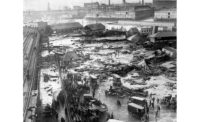With cleanup from the historic flooding in Louisiana likely to go on for some time, occupational safety and health agencies are warning about the hazards that workers and volunteers will face during cleanup activities. Since a great deal of the flooding took place in areas that had never experienced it before, homeowners focused on removing damaged items and restoring their homes may not be fully aware of the dangers, and of what they can do to mitigate them.
According to the National Institute for Occupational Safety and Health (NIOSH), work-related hazards that could be encountered include:
- electrical hazards
- Carbon Monoxide
- musculoskeletal hazards
- heat stress
- motor vehicles
- hazardous materials
- fire
- confined spaces and
- falls
Links to information about hazards associated with storm and flood cleanup can be found below. NIOSH points out that this information can be helpful for those already involved with cleanup activities, and for those who wish to be prepared should they ever have to cope with the aftermath of a natural disaster.
What Services Can CDC/NIOSH Provide to Employers and Employees Involved in Hurricane Recovery? Provides information on work site hazard evaluations available to workers affected by hurricane recovery.
Generator Safety
Preventing electrocutions associated with portable generators plugged into household circuits
Medical Recommendations for Relief Workers and Emergency Responders
NIOSH Interim Guidance for Pre-exposure Medical Screening of Workers Deployed for Hurricane Disaster Work
This document provides interim guidance on medical screening for workers before beginning disaster response activities. It will be updated or revised as appropriate, as additional information becomes available. These materials were developed for Hurricane Katrina but may be applicable for other hurricane responses.
NIOSH Interim Post exposure Medical Screening of Workers Leaving Hurricane Disaster Recovery Areas
Provides Information on working in physically demanding, unclean, or unstable work environments, such as hurricane recovery areas.
CDC Immunization Recommendations for Disaster Responders
Provides information on required immunizations for hurricane responders.
Health Recommendations for Relief Workers Responding to Disasters
Provides a broad scope of information on risks and prevention strategies for relief workers.
Interim Assessment Tools for Occupational Safety and Health in Hospitals, Health Departments, and Shelters Involved in Hurricane Response
These interim forms were developed by NIOSH as survey tools for occupational safety and health purposes in the response to Hurricane Katrina but may be applicable for other hurricane responses. The interim forms are posted here to provide information to occupational safety and health professionals who are interested in NIOSH efforts to prevent injuries and illnesses among hospital, shelter, and health department employees involved in a hurricane response, and who may be looking for tools to ensure health and safety in their own operations.
The interim forms are key to critical information for assessing the potential occupational safety and health impacts of hurricane response on health care, health department, and shelter employees. The interim forms are being used by NIOSH and its colleagues in the U.S. Centers for Disease Control to assess occupational safety and health status and needs for employees in those facilities.
Occupational Health and Safety Survey Tool - Hospitals and Medical Care Facilities
Occupational Health and Safety Survey Tool - ROC/JFO/Health Dept/Field
Occupational Health and Safety Survey Tool - Shelters
Air Quality
NIOSH Interim Recommendations for the Cleaning and Remediation of Flood-Contaminated HVAC Systems: A Guide for Building Owners and Managers
During flooding, systems for heating, ventilating, and air conditioning (HVAC) can become submerged in flood waters. The following recommendations will help ensure that HVAC systems contaminated with flood water are properly cleaned and remediated to provide healthy indoor environments.
Mold Prevention Strategies and Possible Health Effects in the Aftermath of Hurricanes and Major Floods
Extensive water damage after major hurricanes and floods increases the likelihood of mold contamination in buildings. This report provides information on how to limit exposure to mold and how to identify and prevent mold-related health effects.
NIOSH Indoor Environmental Quality Topic Page
"Indoor Environmental Quality," as the name implies, simply refers to the quality of the air in an office or other building environments. Workers are often concerned that they have symptoms or health conditions from exposures to contaminants in the buildings where they work.
NIOSH Alert: Preventing Occupational Respiratory Disease from Exposures Caused by Dampness in Office Buildings, Schools, and Other Nonindustrial Buildings
DHHS (NIOSH) Publication No. 2013-102 (November 2012)
Office buildings, schools, and other nonindustrial buildings may develop moisture and dampness problems from roof and window leaks, high indoor humidity, and flooding events, among other things. For this Alert, we define "dampness" as the presence of unwanted and excessive moisture in buildings.
OSHA Fact Sheet – Fungi Hazards and Flood Cleanup
Carbon Monoxide
NIOSH Carbon Monoxide Hazards from Small Gasoline Powered Engines Topic Page
Small gasoline-powered engines, such as generators, can pose a serious health hazard following natural disasters. They produce high concentrations of CO--a poisonous gas that can cause illness, permanent neurological damage, and death. This web page provides recommendations for employers, equipment users, tool rental agencies, and tool manufacturers for preventing CO poisoning.
CDC Carbon Monoxide Poisoning Topic Page
This web page contains reports detailing the problems associated with carbon monoxide from portable generators, motorboats, fires, and other emission sources.
Cleanup Hazards
CDC Hurricanes - Health and Safety
The Centers for Disease Control and Prevention resource for Hurricane recovery and preparedness. Includes key facts, food and water safety, Mental Health, Electrical Hazards and more...
NIOSH Warns of Hazards of Flood Cleanup Work
DHHS (NIOSH) Publication No. 94-123 (1994)
En Español
An overview of hazards present in cleanup operations and ways to prevent illnesses and injuries.
NIOSH Emergency Response Resources - Natural Disasters
A sub-page of the NIOSH Emergency Response Resources Area containing links to information about natural disasters, flood and hurricane response, and personal protective equipment.
OSHA Fact Sheet—Keeping Workers Safe During Hurricane Sandy Cleanup and Recovery
Confined Spaces
NIOSH Confined Spaces Topic Page
"Confined Space" refers to a space which by design has limited openings for entry and exit, unfavorable natural ventilation which could contain or produce dangerous air contaminants, and which is not intended for continuous employee occupancy.
NIOSH Interim Guidance: Working Safely in Confined Spaces
This document provides NIOSH interim guidelines regarding work in confined spaces in response to a hurricane. Flooding and hazardous materials spills or releases may create dangerous confined spaces in basements and enclosed rooms. Similarly, building damage and collapses may create confined space hazards by restricting entry and exit and exposing workers to physical or environmental hazards.



